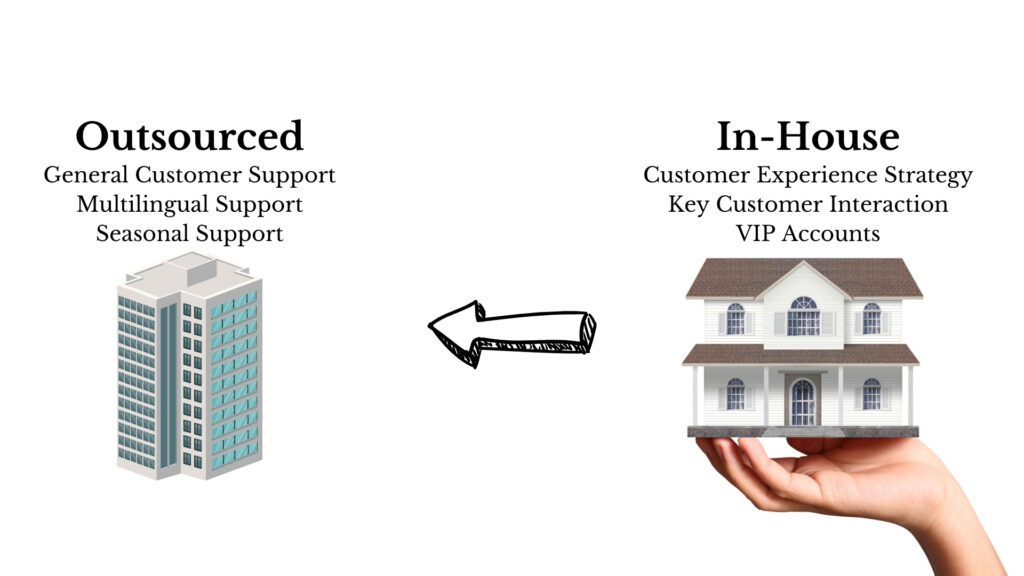Welcome to Third party
Outsourcing vs. In-House Which one is right for your business?
October, 2024
Outsource... in-house... which one should I choose?
Growing businesses quite often face this question; they see how both options can be beneficial. They see how an outsource solution can bring down cost, take the burden of certain tasks off their shoulders, and save them time, but they also see how an in-house team will grant them more control over their operations.
In this blog, we will analyze them so you’re able to make an informed decision.
Topics:
- What is In-House Staffing?
- What is Outsourcing?
- When In-House Makes Sense
- When Outsourcing is the Best Choice
- Hybrid Models: The Best of Both Worlds?
- Conclusion
¿What is In-House Staffing?
Full control 🏠
In-house staffing means hiring and managing employees directly within your company instead of outsourcing tasks to external agencies or freelancers. These team members work under your supervision, are part of your company culture, and handle key functions, giving you more control over operations, communication, and quality.
¿What Is Outsourcing?
An extra set of expert hands 🤝
As explained before in the introduction, outsourcing is contracting specific tasks, functions, or processes to an external party rather than handling them within your organization. This really can be anything from customer service and IT support to marketing, accounting, or even manufacturing. The goal is to delegate, preferrably to a specialized provider or firm, either domestically or internationally.
Key Differences Between Outsourcing and In-House
In-house control vs. outsourced flexibility 🙆🏻♂️
Each option has its own set of benefits and challenges, and understanding these can help you make the best decision for your business goals. Let’s explore the key differences to see which approach aligns with your needs.
1. Cost Efficiency 
In-House: Higher costs due to salaries, benefits, training, and office space.
Outsourcing: Often more cost-effective due to reduced overhead and operational costs.
2. Expertise and Skill Set 
In-House: You have control over hiring specific skill sets, but training may be required for new skills.
Outsourcing: Immediate access to specialized expertise without needing to invest in training.
3. Scalability
In-House: Scaling an in-house team can be slow and costly, especially if rapid growth is required.
Outsourcing: Easier to scale up or down depending on business needs, as providers typically have the infrastructure to handle fluctuations.
4. Control and Supervision 🎮:
In-House: Direct control over day-to-day operations and immediate supervision.
Outsourcing: Less direct control, but a good outsourcing partner will align with your business goals and offer transparency.
 :
: Outsourcing: Frees up time and resources to focus on core competencies, such as product development or sales.
5. Risk and Accountability 
In-House: Risks like employee turnover or underperformance are the company’s responsibility.
When In-House Makes Sense
For businesses navigating the decision between in-house teams and outsourcing, there are scenarios where in-house staffing remains the best approach. Consider keeping tasks in-house when:
Control
For businesses that need full control over sensitive tasks.
Culture Development
When long-term staff development and company culture are priorities.
Critical Processes
For critical functions that require constant, close management.
When Outsourcing is the Best Choice
For businesses navigating the decision between in-house teams and outsourcing, there are scenarios where in-house staffing remains the best approach. Consider keeping tasks in-house when:
Cost & Flexibility
For businesses looking to reduce costs or increase flexibility.
Specialized Skills
When specialized skills or expertise are needed without the burden of hiring full-time staff.
Scaling
For companies focused on scaling quickly or shifting resources to core activities
The Hybrid Model
The Best of Both Worlds? 🌎
A hybrid model allows businesses to keep control over essential tasks by handling them in-house while outsourcing non-core functions to external experts. This way, companies can focus on what they do best, maintain quality, and still benefit from the flexibility and cost savings of outsourcing. It’s a strategic approach that combines the best of both worlds, optimizing resources and driving growth.

Conclusion
If you’re considering outsourcing to streamline operations and focus on growth, connect with us by filling out the form below. Our team is ready to provide a custom solution that fits your business needs.

We would love to discuss any inquiries with you.


